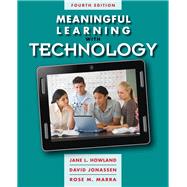
Note: Supplemental materials are not guaranteed with Rental or Used book purchases.
Purchase Benefits
What is included with this book?
Dr. David Jonassen is Curators’ Professor at the University of Missouri where he teaches in the areas of Learning Technologies and Educational Psychology. Since earning his doctorate in educational media and experimental educational psychology from Temple University, Dr. Jonassen has taught at the University of Missouri, Pennsylvania State University, University of Colorado, the University of Twente in the Netherlands, the University of North Carolina at Greensboro, and Syracuse University. He has published 35 books and hundreds of articles, papers, and reports on text design, task analysis, instructional design, computer-based learning, hypermedia, constructivism, cognitive tools, and problem solving. His current research focuses on the cognitive processes engaged by problem solving and models and methods for supporting those processes during learning, culminating in the book, Learning to Solve Problems: A Handbook for D e signing Pro b lem-Solving Learning Environments.
Rose M. Marra, Ph.D., is an Associate Professor at the University of Missouri in the School of Information Science and Learning Technologies. Dr. Marra teaches courses on assessment, evaluation and the design and implementation of effective online learning experiences. She holds a Masters degree in Computer Science and worked as a software engineer for AT&T Bell Laboratories before completing her Ph.D. and beginning her career in academia at Penn State University in their College of Engineering. At Penn State, she began her advocacy for and research into women and girls in STEM careers. Specific research interests include factors that influence persistence of women in STEM, women’s self-efficacy in studying and completing STEM degrees, gender differences in perceptions of STEM classroom climates, and the epistemological development of college students. Dr. Marra has been PI or Co-PI on numerous funded research projects including the Assessing Women and Men in Engineering (aweonline.org) and the National Girls Collaborative Project (http://www.psctlt.org/ngcp/).
Chapter 1: Goal of Technology Integrations: Meaningful Learning
Chapter Objectives
How Can Technology Facilitate Meaningful Learning?
Alternative Conceptions of Meaningful Technology Use
Conclusion
Things to Think About
Chapter 2: Inquiring with Technologies
Chapter Objectives
Technology Trends Supporting Inquiry
Information Gathering With Internet Resources
Using Information to Build Knowledge with Open-Ended, Student-Directed Research Projects
Collecting Data with Mobile Technologies
Finding Opinions with Online Survey Tools
Conclusion
NET Standards and 21st Century Skills
Things to Think About
Chapter 3: Experimenting with Technologies
Chapter Objectives
Learning to Reason Causally
Hypothesizing With Microworlds
Experimenting With Simulations
Venturing Into Games
Immersing Into Virtual Worlds
Conclusion
NET Standards and 21st Century Skills
Things to Think About
Chapter 4: Designing with Technologies
Chapter Objectives
Learning through Design
Drawing Design Ideas with SketchUp
Testing Designs and Building Mental Models with Simulation Software
Problem Solving Through Game and Simulation Design
Designing Music with Composition Software
Conclusion
NET Standards and 21st Century Skills
Things to Think About
Chapter 5: Communicating with Technologies
Chapter Objectives
21st Century Media Kids
Exchanging Ideas Asynchronously With Discussion Boards and VoiceThread
Exchanging Ideas Synchronously With Chats and Instant Messaging
Sharing Information with Presentation Technologies
Making Connections through Videoconferencing
Broadcasting With Podcasts and Internet Radio
Conclusion
NET Standards and 21st Century Skills
Things to Think About
Chapter 6: Community Building and Collaborating with Technologies
Chapter Objectives
What is Community?
Knowledge Building with Knowledge Forum
Co-constructing Knowledge with Wikis
Building International Communities with iEARN, Global Schoolhouse, KidLink, and ThinkQuest
Discussing Interests with Social (Educational) Networking Groups
Conclusion
NET Standards and 21st Century Skills
Things to Think About
Chapter 7: Supporting Writing with Technology
Chapter Objectives
Supporting Writing Organization, Planning and Reflection on Writing through Visualization Tools
Supporting Creative Writing and Publishing with Technology
Supporting Collaborative Writing with Technology
Supporting Peer Feedback on Writing
Conclusion
NET Standards and 21st Century Skills
Things to Think About
Chapter 8: Modeling with Technologies
Chapter Objectives
Learning by Building Models
Modeling Knowledge with Concept Maps
Modeling with Spreadsheets
Modeling Experiences with Databases
Conclusion
NET Standards and 21st Century Skills
Things to Think About
Chapter 9: Visualizing With Technologies
Chapter Objectives
What Are Visualization Tools?
Visualizing Scientific Ideas with Computers
Visualizing Mathematical Ideas with Technologies
Visualizing With Digital Cameras and Mobile Phones
Visualizing With Video
Video Modeling and Feedback
NET Standards and 21st Century Skills
Things to Think About
Chapter 10: Assessing Meaningful Learning and Teaching with Technologies
Chapter Objectives
Assessing Meaningful Learning: Authentic and Performance Assessment
Technology-Based Assessments
Assessing Performance with Technology-Based Rubrics
Assessing Growth over Time with Electronic Portfolios
Clicker Assessment Tools
Assessing Learning with Technology-Based Tests, Surveys and Assessment Items
Conclusion
NET Standards and 21st Century Skills
Things to Think About
Epilogue: Implications of Learning with Technology
Index
The New copy of this book will include any supplemental materials advertised. Please check the title of the book to determine if it should include any access cards, study guides, lab manuals, CDs, etc.
The Used, Rental and eBook copies of this book are not guaranteed to include any supplemental materials. Typically, only the book itself is included. This is true even if the title states it includes any access cards, study guides, lab manuals, CDs, etc.